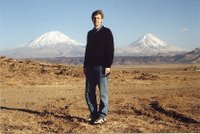 |
| Tall el-Hammam overlooking the Jordan Valley |
The area around Tall el-Hammam (TeH), in the Late Bronze Age, is identified by most scholars as Abel Shittim (Heb. meaning “Acacias of Mourning”), which is the location of Israel’s encampment prior to entering the Promised Land (Num 25:1, Deut 34:9; Josh 2:1; 3:1). In Merrill’s article under the section titled “The Shittim Plain,” he states:
When the Hebrews came down from the mountains of Moab, they pitched from Beth Jeshimoth on the south, to Abel Shittim on the north, and their tents must have covered the whole plain. . . . between Tel Kefrein and Tel er Eama [sic Tall er-Ramah] on the west, and the mountains on the east, there are two important tells which remain to be noticed. These are Tel el Hammam in the north, where there are extensive ruins and a hot spring [5 hots springs]; and Tel Ektanu [Iktanu] in the south [emphasis added]. [1]
The NIV Archaeological Study Bible identifies Tall el-Hammam as Abel-Shittim, however it gives no archaeological evidence for this identification, perhaps because its identification is based on geographic location instead of physical discoveries [2]. In Moses day (Late Bronze period) the region of Abel-Shittim, below Mt. Pisgah (beside Mt. Nebo), was described as a “desert” (“wasteland below Pisgah” Num 21:20 NIV; “Bamoth to the valley lying in the region of Moab by the top of Pisgah that looks down on the desert” Num 21:20 ESV).
Perhaps better than identifying a site with Shittim we should be looking at an event known as the mourning of the Acacia trees (Abel Shittim) and a region on the plain around Tall el-Hammam.
While Moses and Joshua were camped out around TeH they did not leave behind much in the way of discernible artifacts. There is a small LB structure on the acropolis of Tall el-Hammam that was likely a watch/signal tower to communicate with Jerusalem, Jericho and other cities around the Jordan Valley.
_________________________
Footnotes
[1] Merrill, Selah. “Modern Researches in Palestine.”
Journal of the American Geographical Society of New York 9 (1877): 109–25 [see
117]; Merrill, Selah. “Modern Researches in Palestine.”
Palestine Exploration Fund: Quarterly Statement (PEFSt). 11, no. 1 (1879): 138–54 [see
144].
[2] Walter C. Kaiser, Jr., and Duane Garrett, eds.
NIV Archaeological Study Bible: An Illustrated Walk Through Biblical History and Culture (Grand Rapids: Zondervan, 2006), 233.
Bibliography
Aharoni, Yohanan. The Land of the Bible: A Historical Geography. Translated by Anson F. Rainey. 2nd ed. Louisville: Westminster/Knox, 1981), 419.Avi-Yonah, Michael. The Madaba Mosaic Map with Introduction and Commentary (Jerusalem: Israel Exploration Society, 1954), 37.
Davies, Graham I. The Way of the Wilderness a Geographical Study of the Wilderness Itineraries in the Old Testament. SOTSMS 5 (Cambridge: Cambridge University Press, 1979), 36.
Glueck, Nelson. Explorations in Eastern Palestine II. AASOR 15. (New Haven, CT: ASOR, 1935), 378;
Glueck, Nelson. “Some Ancient Towns in the Plains of Moab.” BASOR 91 (1943): 7–26 [see 15].
Harrison, R. K. “Shittim,” ed. Edward M. Blaiklock, The New International Dictionary of Biblical Archaeology (Grand Rapids, Mich.: Zondervan, 1983), 413.
Kaiser, Jr., Walter C., and Duane Garrett, eds. NIV Archaeological Study Bible: An Illustrated Walk Through Biblical History and Culture (Grand Rapids: Zondervan, 2006), 233.
Khouri, Rami G. Antiquities of the Jordan Rift Valley (Manchester, MI: Solipsist, 1988),76.Miller, J. Maxwell and Gene M. Tucker, The Book of Joshua, The Cambridge Bible Commentary of the English Bible (Cambridge, Mass.: Cambridge University Press, 1974), 199.
MacDonald, Burton, East of the Jordan: Territories and Sites of the Hebrew Scriptures, ed. Victor H. Matthews, ASOR Books 6 (Boston, MA: American Schools of Oriental Research, 2000), 90.
Merrill, Selah. “Modern Researches in Palestine.” Journal of the American Geographical Society of New York 9 (1877): 109–25 [see 117].
Merrill, Selah. “Modern Researches in Palestine.”
Palestine Exploration Fund: Quarterly Statement (PEFSt). 11, no. 1 (1879): 138–54 [see
144].
Negev and Gibson, call the site Tell el-Harman [sic. Tall el-Hammam] “Abel Shittim; Shittim, ” in The Archaeological Encyclopedia of the Holy Land (1 Vol., Rev and updated ed. Avraham Negev and Shimon Gibson, 3rd ed. 2001), 1.
Slayton, Joel C. “Shittim.” In
Anchor Bible Dictionary, edited by David Noel Freedman (New York: Doubleday, 1996), 5:1222.
Thomson, William M.
The Land and the Book: Lebanon, Damascus, and Beyond Jordan. Vol. 3. 3 vols. (New York, NY: Harper & Brothers, 1886), 3:669.
Walton, John H., Victor H. Matthews, and Mark W. Chavalas.
The IVP Bible Background Commentary: Old Testament (Downers Grove, IL: InterVarsity Press, 2000),
169, 213.






